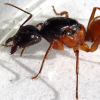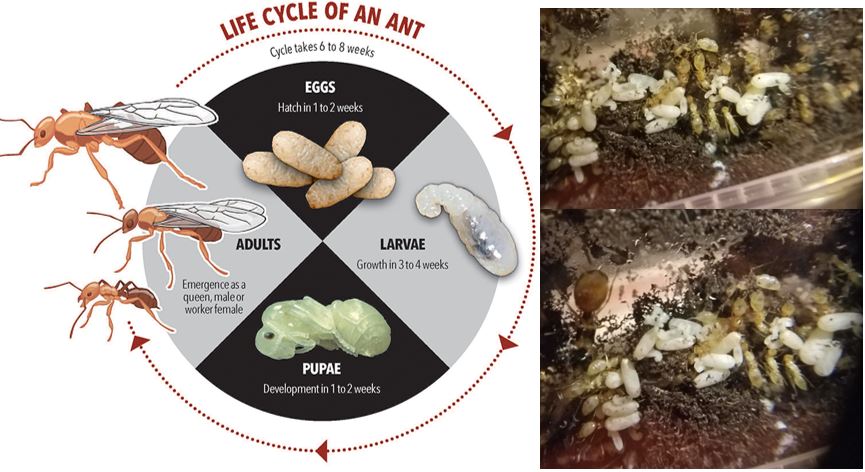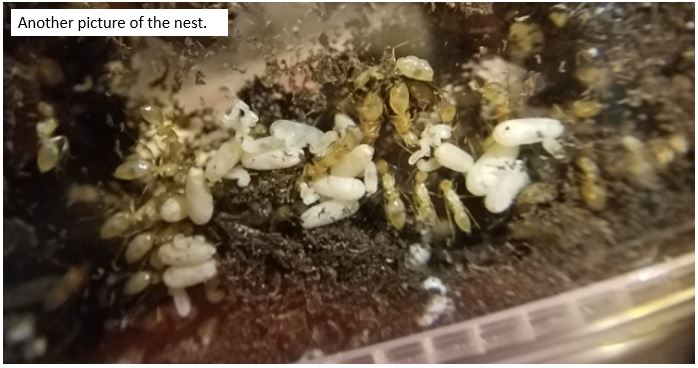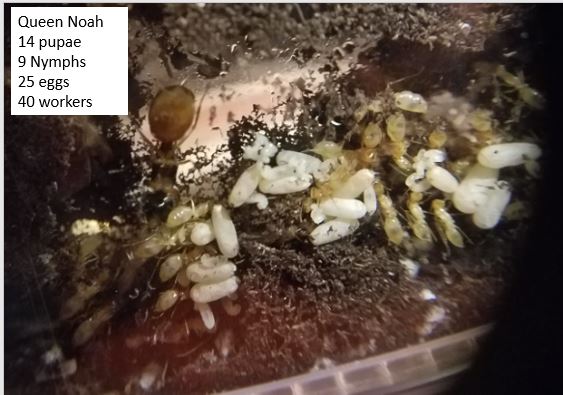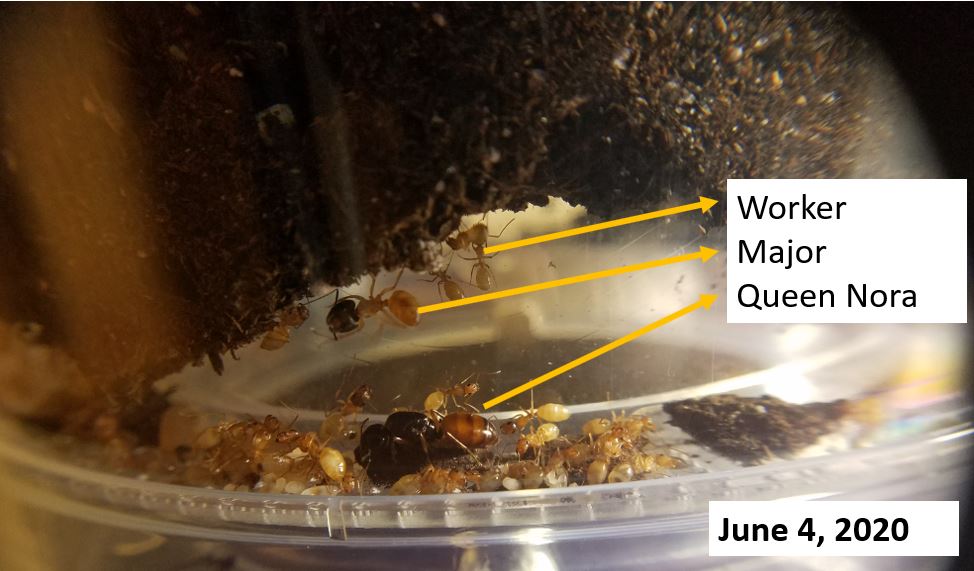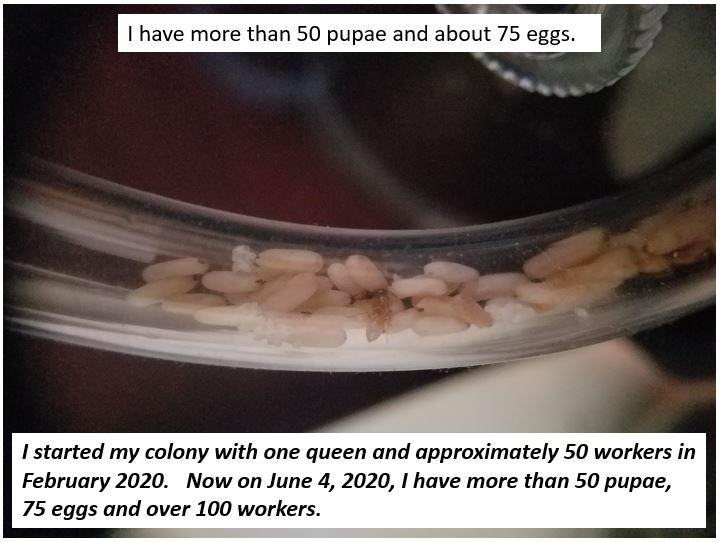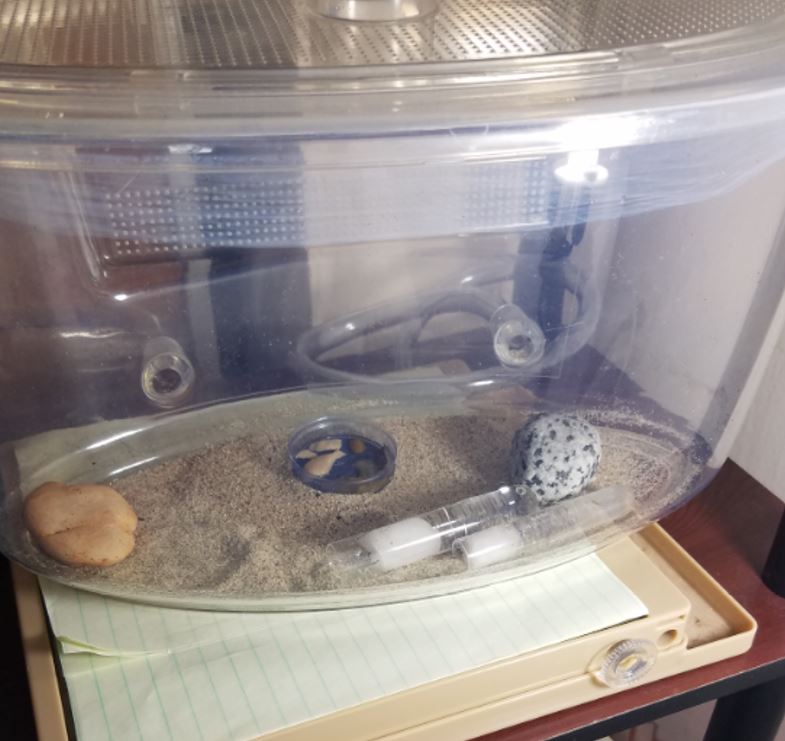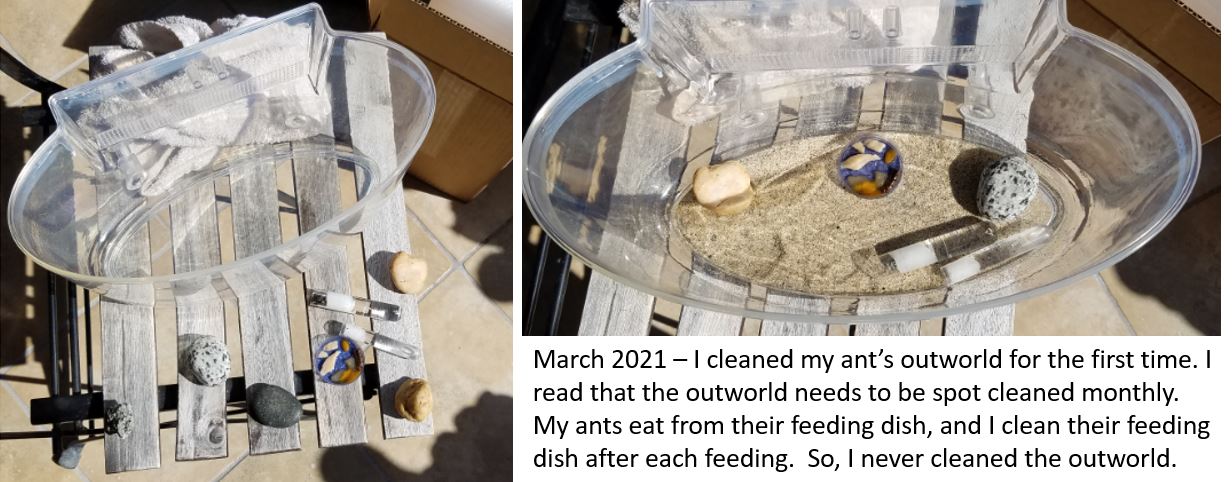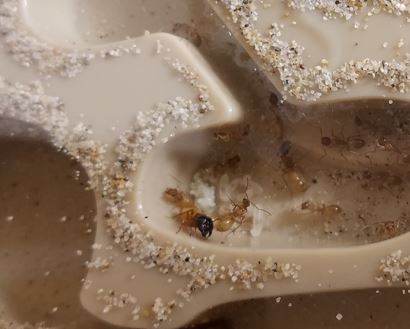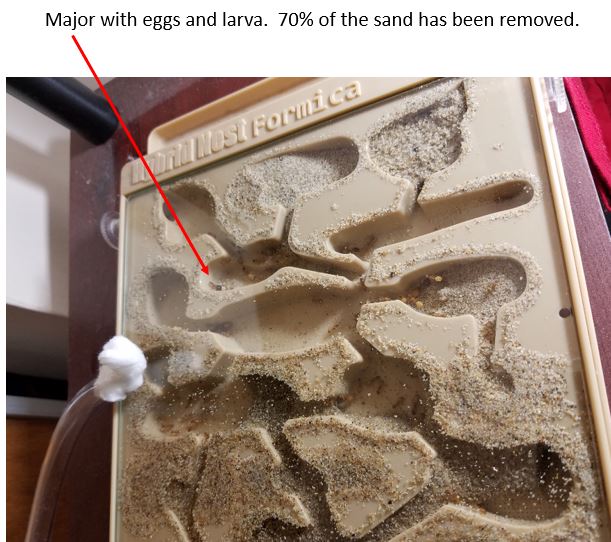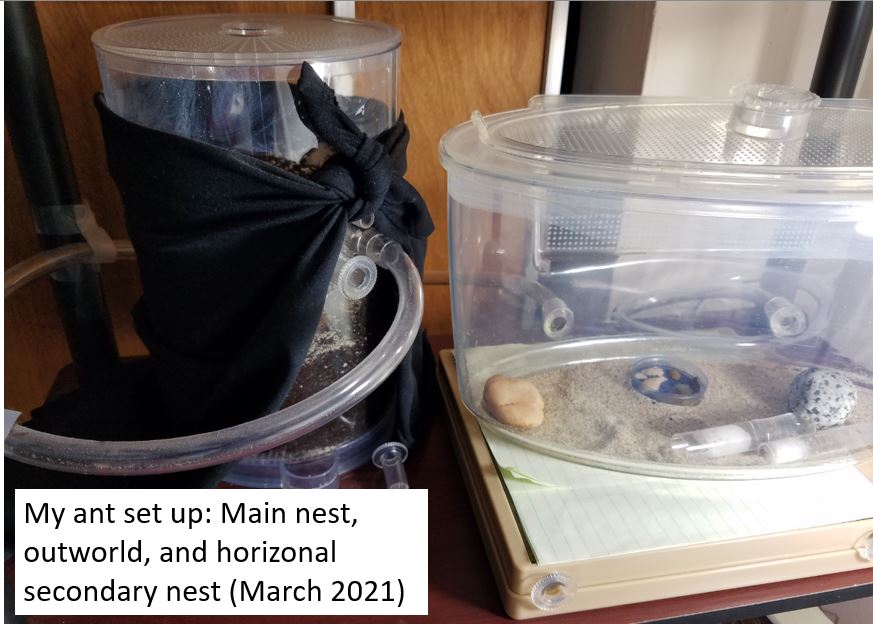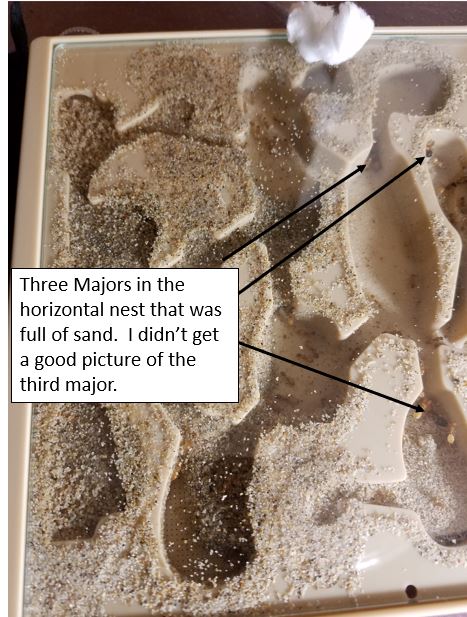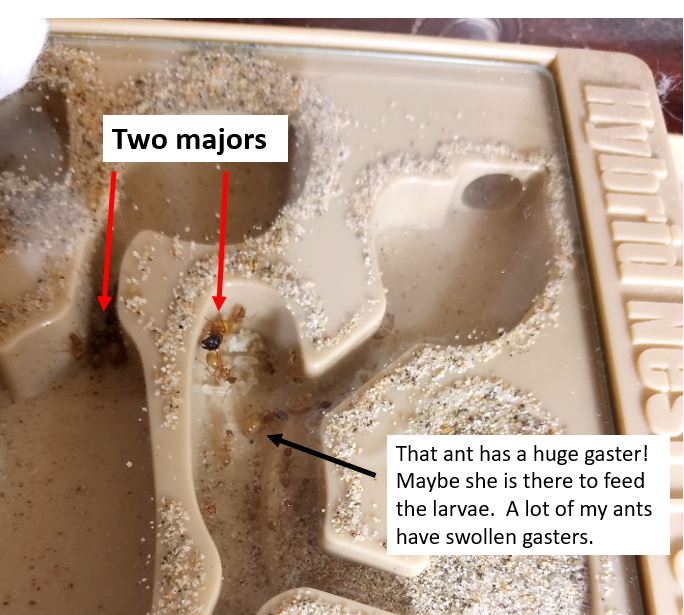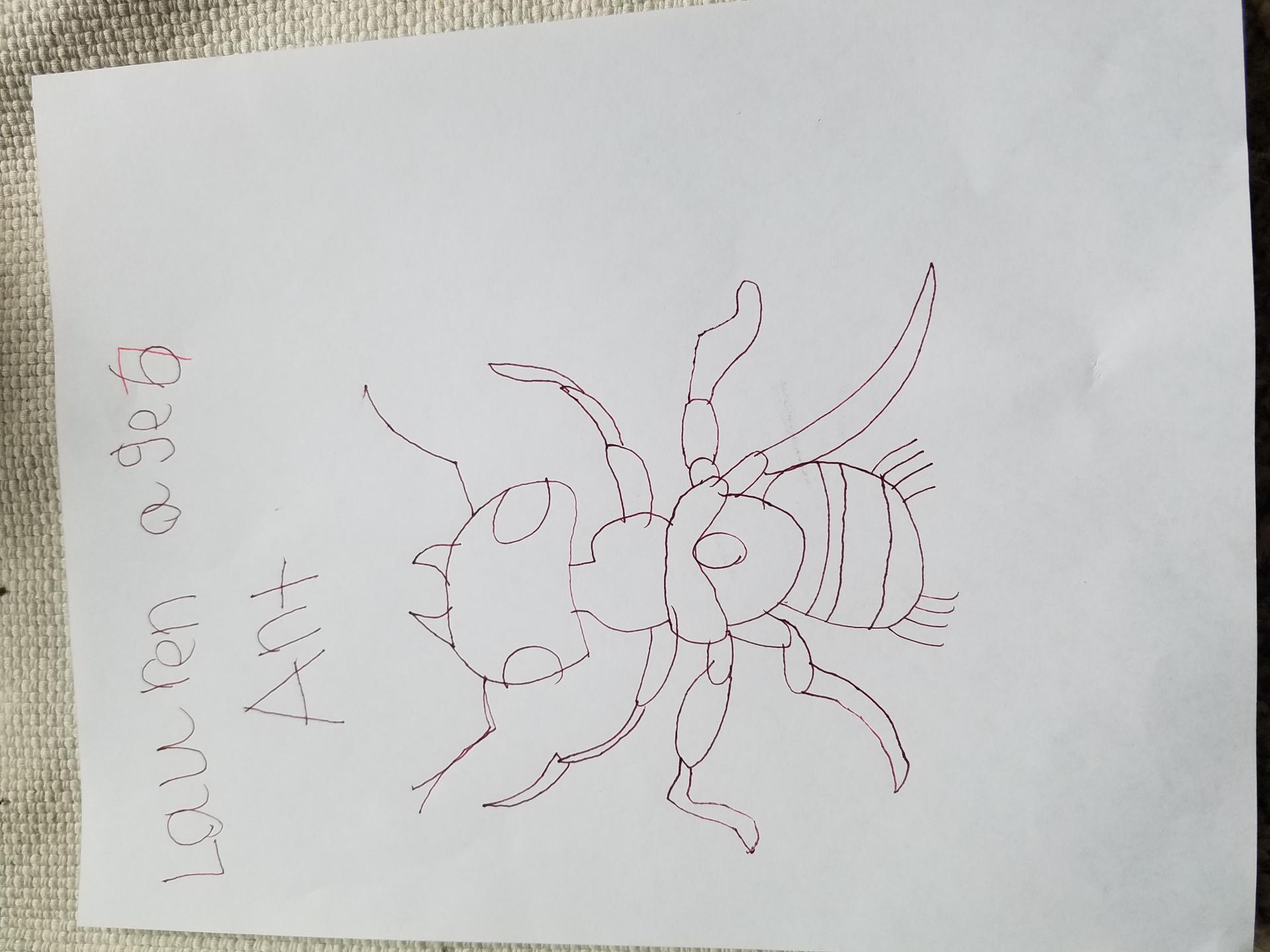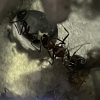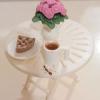Camponotus semitestaceus – This is what I learned about ants from raising the granddaughter’s ant colony for one year (Feb. 2020 to March 2021). I’ve included a picture my granddaughter Lauren drew of an ant. She turned 7 years old on March 4th.
Initially, I was worried about the humidity, temperature, hibernation, and nutrition of the colony.
Humidity: I had read several research papers that described the danger of mold in ant formicarium. I obsessively monitored the formicarium’s temperature, humidity, and light levels for months. After collecting data for about six months, I discovered that the humidity in the outworld was between 55% and 65%, while the humidity inside the nest was as high as 100% (shown by condensation on the inside of the formicarium) in the morning. My formicarium was filled with organic potting soil. There were dry areas and moist areas inside the formicarium, and the ants preferred the damp areas. No mold outbreak occurred. The ants chose to nest in the wet nest areas, and the queen liked the bottom of the nest above the water reservoir. I kept water in the water reservoir under the formicarium but a few times I forgot, and although there was no water in the reservoir, the soil was damp and the ants were okay. So, I stopped obsessing over the humidity because the ants were thriving. I set a reminder to add water to the reservoir every two weeks.
Temperature: The temperature inside my home varies between a low of 60 F in the winter to 85 F in the summer, and this temperature range is within the normal range for Camponotus semitestaceus. I use a small reptile heat pad to warm the formicarium from February 2020 to July 2020. I angled the heating page against the formicarium to create zones of differing heat intensities. The point of contact between the heat pad and the container is warmest near the top. It is coolest near the bottom because the pad is further away. The ants migrated to the upper and middle parts of the nest directly under the heat source. In July 2020, the inside temperature of my home reached 88 F! I forgot to turn off the heating pad. I thought I killed the colony. But I didn't because the ants moved to the other side of the formication away from the heat pad. After that scare, I turn off the heat because July and August are the hottest months in my area.
Hibernation: I reviewed many research papers, read online message boards, and perused online websites to determine if Camponotus semitestaceus needed to hibernate. Camponotus ants that are native to areas near 60 north latitude/temperate regions or in the mountains will naturally hibernate regardless of the air temperature. Fortunately, Camponotus semitestaceus are native to areas near 38 latitude/arid areas do not hibernate. I was afraid to keep the nest warm all winter because I thought the additional heat would encourage Olivia to continuously lay eggs, and excessive egg laying without a break could shorten her life expectancy. So, I removed the heat from October 2020 to February 2021 but continued their regular feedings. I discovered in February 2021 that Olivia laid a lot of eggs over the winter, and the colony successfully raised fifteen super majors, and countless workers in a room with a temperature between 63 F to 67 F. In February 2021, I found three super majors with a clutch of thirty eggs and larvae in the unheated secondary nest. So, Camponotus semitestaceus species that are native to low lying Coastal California do not hibernate, and the colony will continue to grow if food is abundant and the room temperature is above 63 F.
Nutrition: I feed the ants a variety proteins, fruits and syrups twice a week because I read that Camponotus ants can be "picky eaters." After feeding, the worker ant's gaster/social stomach swells and becomes an opaque yellow. (I thought the workers with opaque gasters were a fourth caste of ant: Queen, workers with small gaster, workers with opaque yellow gaster, and super majors.) These ants with the opaque gasters (I assume) feed other workers, larvae, and Olivia by a process called trophallaxis. About 40% of the ants I see in the outworld and about 50% of the ants in the nest have have enlarged opaque gasters. The ant colony is eating an abundantly varied diet and have access to clean water and hummingbird nectar all the time. Their population increase over the winter was a surprise because I thought warmth triggered egg laying. Apparently, food quality and quantity play a larger role for Camponotus semitestaceus kept in a formicarium. Although Camponotus semitestaceus is nocturnal, I see ant activity throughout the day and night as worker ants excavate a secondary nest. The colony's winter growth, abundant ants with opaque gasters, continued excavation of a secondary nest, and nesting and protection of eggs and larvae in the secondary nest by three super majors imply that these ants nutritional needs are being met.
I feed the a selection of the below items twice a week:
- Frozen Worms: I remove the worm from the Ziplock bag, cut it in half, and then I cut it vertically to get the ants to access the worm's interior and put the pieces in their feeding dish.
- Frozen Crickets: I remove the frozen cricket, cut its body in half and put it in the feeding dish.
- Baby Food: I feed the ants baby food, and I freeze the uneaten portions in Ziplock bags. The ants love the chicken!
- Canned Pet Food: I read online that ants can eat canned cat and dog foods. I add a little cat food every two weeks in addition to their usual protein sources.
- Protein Powder: I read online that some ants will consume protein powder (mixed with water) but only if other protein sources are not available. Protein powder is not a healthy protein source for ants. I occasionally supplement their diet with a bit of protein powder paste. I don’t know if they eat it, but it is there if they want to eat something new.
- Syrups: I learned that I was incorrectly feeding syrup to the ants. Rather than just adding a drop to their feeding dish, I discovered that I was supposed to add water to it (70% syrup and 30% water) because ants have difficulty consuming thick syrups like honey and molasses.
- Raw Chicken and Beef: I feed the ants blanched raw chicken and ground beef every other month.
- Live Insects: Last year, I fed the colony two caterpillars I found in the garden, three silverfish I caught in the bathroom, and ten silverfish larva I captured around the cat's feeding dish. The workers brought the queen their freshly killed insects. This was unexpected because the workers consume the frozen foods in their feeding dish and carry it back to the colony in their social stomachs, but live insects are killed, and their bodies are brought into the nest.
- Live Feeding Dangers: I have read about the dangers of feeding ants live insects: (1) mite infestations, (2) bacterial and viral infections, (3) pesticide poisoning, and (4) ant injury. I will reduce the risk of the above dangers by limiting live feedings to three times a year, and carefully observing insects before putting them in the formicarium. I will limit feeder insects to caterpillars from my garden, silverfish in my home, and fruit I hand raise.
Limit Disturbances to the Formicarium: I keep my formicarium covered and I only disturb the ants when I add food, replenish water and hummingbird nectar test tubes, or add water to the reservoir at the bottom of the formicarium.
Expected Colony Growth Year 1 to Year 4. Approximate Camponotus colony growth is listed below:
- Year 1: 10 to 30 workers
- Year 2: 30 to 100 workers (January 2020/a queen with approximately 50 workers)
- Year 3: 50 to 250 workers (January 2021/a queen, more than 100 workers, and 15 super majors)
- Year 4: 100 to 1000 (January 2022/ a queen with (?) workers, and (?) super majors)


